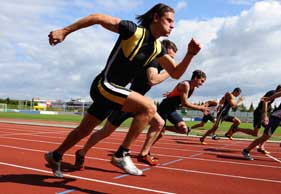Run short, run fast… This is definitely
not the motto of most runners who are looking to compete at marathons, ultras
and the Comrades, which are all races that require you to run slowly, but for a
long time. I honestly believe that most runners, however, would love to run
fast! Think about it: Why is the Olympic 100m event always the most watched
event at the games? Because we love
speed, in all its forms!
Now remember, speed is relative, which
means we can all run fast relative to
our age, gender and ability. However, many runners say they don’t do speed work
because they are not fast enough. This is actually nonsense. Fast for you may
not be fast for your running partner, and certainly not for Usain Bolt, but it
is still fast. And the first rule of
running fast is simple: Run short.
Now this
may seem logical to you, but many runners still worry about the distance they
run during a training session rather than the intensity. Short means shorter
distance and fewer repetitions. There is only one way to get to run faster, and
that is to teach your legs what it feels like to run faster. To do that you
have to do training workouts that accomplish exactly that: Get your legs used
to running fast. And make it fun! So here are some of the training sessions
that you can do to learn the technique of running fast.
1.
STRIDING THE STRAIGHTS
This session is usually done around an
athletic track, but it can also be done on a rugby/soccer field. After a easy
warm up of 3 to 5km with some faster striding, do the following:
?
Run the strait of the track fast – not quite
a sprint, but at a pace that you could only maintain for a short while. This
means about 100m at close to full speed, before slowing down to a jog around
the bend of the track, then running the back straight fast again. Cover
anything from 8 to 12 laps of the track this way (about 2.5 to 3.5km).
?
The good part about this training is
that the rest period is not structured in terms of the recovery period – you
can jog or even walk the bends until you feel fully recovered to run another
100m fast. As you get fitter this recovery jog will get faster but always focus
on the fast 100m runs.
2. FARTLEK
Fartlek was invented in 1937 by Swedish
coach Gosta Holmer and the name roughly translates as ‘speed play.’ True
fartlek is about mixing up faster-than-race pace efforts with easier recovery
running, and it is an effective and satisfying training session that should always
be fun!
?
Run with a partner and each of you will be
responsible for 20 minutes during which you decide how fast and how far you
run. Try to do this in a large park/cross-country area, but you can also do it
on the road.
?
Start with an easy-paced warm-up of
around 4km, with a few faster surges.
?
The first ‘leader’ will then say, “Let’s
sprint to that tree,” or “Let’s run hard for two minutes.” The same applies to
the rest periods. After 20 minutes you swap around.
?
After finishing 40 minutes of running
freely like this, you will be left feeling strong and invigorated, and can jog
another 3km as a cool-down.
This is running in its purest form – no kay
markers, GPS, or heart rate monitors, just fast running at its best!
GETTING
HOT IN HERE
With summer approaching it is an ideal
time to run fast, and here are some pointers for planning your fast training
runs:
?
Shorten your long runs – 15km to 20km
maximum.
?
Cut weekly mileage – run less days
during the week, and shorter distances overall.
?
Race at shorter distances – find a 5km
race or time trial and give it a full go.
?
Get back onto the track or field – still
the best place to run fast!
?
Remember that rest and recovery are just
as important after faster running as when doing long runs.
Now, what are you waiting for? Get out
there and discover the joys of faster running!


